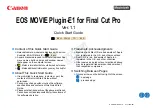
■
Two new AC power supply modules in chassis
—The JUNOS Software now
supports two new AC power supply modules on T640 and T1600 routers: AC
Power Entry Module 10kW US and AC Power Entry Module 10kW EMEA (for
U.S. and EMEA markets, respectively). The two Power Entry Modules (PEMs)
cannot interoperate and the JUNOS Software reports an alarm when they do.
The
show chassis environment pem
command output will show
AC Input:
status
instead of
DC Input:
status and the
Temperature
will show the actual temperature
reading. Two new power supply descriptions, US and EMEA, are added to
distinguish the new modules from existing ones in the output of the
show chassis
hardware
command output.
[
System Basics and Service Command Reference
]
■
Next-hop cloning and permutations disabled in T Series enhanced scaling
FPCs (FPC Type 1-ES, FPC Type 2-ES, FPC Type 3-ES, and FPC Type 4-ES)
—The
next-hop cloning and permutations are now disabled in these FPCs with enhanced
load-balancing capability. As a result, the memory utilization is reduced for a
highly scaled system with a high number of next hops on ECMP or aggregated
interfaces.
[
System Basics
]
■
Fragmentation support for GRE-encapsulated packets (Multiservices DPC)
(M120, M7i/M10i with enhanced CFEB, M320 with E3 FPC, and MX Series
routers only)
—Enables the Packet Forwarding Engine to update the IP
identification field in the outer IP header of packets encapsulated with generic
routing encapsulation (GRE), so that reassembly of the packets is possible after
fragmentation. The previous CLI constraint check that requires you to configure
either the
clear-dont-fragment-bit
statement or a tunnel key with the
allow-fragmentation
statement is no longer enforced. There are no associated
changes to the CLI statements or operational mode commands.
NOTE:
For other routers, the earlier configuration constraint check still holds.
[
Services Interfaces
,
MPLS Applications
,
MX Series Layer 2 Configuration Guide
]
■
NAT compliance enhancements
—Add modifications to the existing NAT
functionality on the services PICs to achieve compliance with RFCs UDP 4787,
TCP 5382, and ICMP 5508. These enhancements apply to IPv4–IPv4, IPv6–IPv6,
and IPv4–IPv6 source NAT and are not supported with destination NAT. New
CLI configuration settings associated with RFC 4787 include the
mapping-timeout
statement at the
[edit services nat pool
pool-name
]
hierarchy level and the
address-pooling
,
filtering-type
, and
mapping-type
statements at the
[edit services
nat rule
rule-name
term
term-name
then translated]
hierarchy level. There are no
associated changes to the operational mode commands.
[
Services Interfaces
]
■
Support for VRF in Routing Engine-based sampling on M Series, M320, MX
Series, M120, and T Series routers
—For VRF Routing Engine-based sampling,
the kernel queries the correct VRF route table based on the ingress interface
index for the received packet. For interfaces configured in VRF, the sampled
packets contain the correct input and output interface SNMP index, the source
and destination AS numbers, and the source and destination mask.
New Features in JUNOS Release 10.1 for M Series, MX Series, and T Series Routers
■
15
New Features in JUNOS Release 10.1 for M Series, MX Series, and T Series Routers
















































